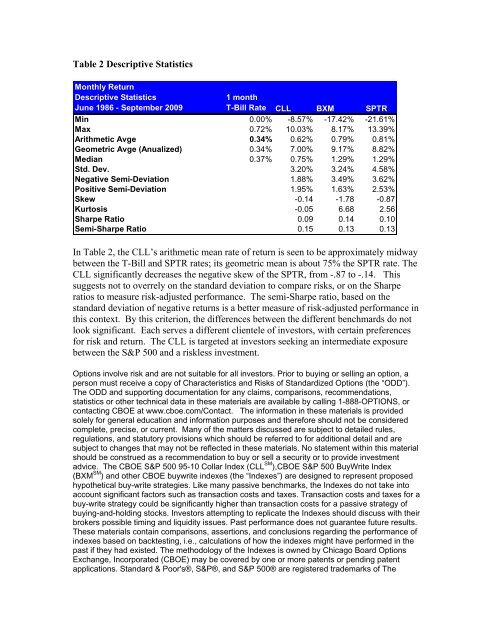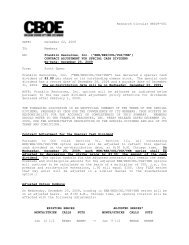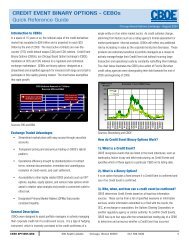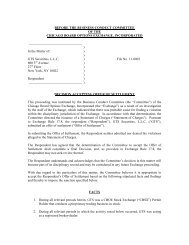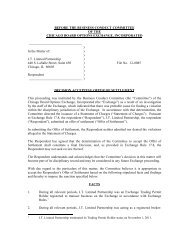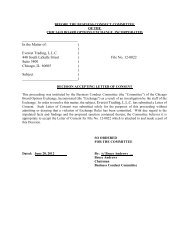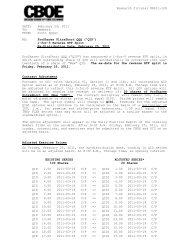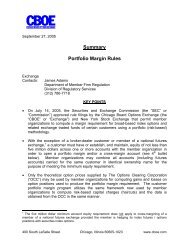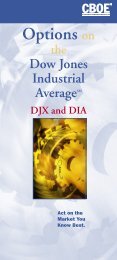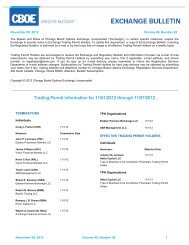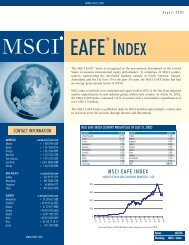CBOE S&P 500 95-110 Collar Index (CLL) - CBOE.com
CBOE S&P 500 95-110 Collar Index (CLL) - CBOE.com
CBOE S&P 500 95-110 Collar Index (CLL) - CBOE.com
Create successful ePaper yourself
Turn your PDF publications into a flip-book with our unique Google optimized e-Paper software.
Table 2 Descriptive Statistics<br />
Monthly Return<br />
Descriptive Statistics<br />
June 1986 - September 2009<br />
1 month<br />
T-Bill Rate <strong>CLL</strong> BXM SPTR<br />
Min 0.00% -8.57% -17.42% -21.61%<br />
Max 0.72% 10.03% 8.17% 13.39%<br />
Arithmetic Avge 0.34% 0.62% 0.79% 0.81%<br />
Geometric Avge (Anualized) 0.34% 7.00% 9.17% 8.82%<br />
Median 0.37% 0.75% 1.29% 1.29%<br />
Std. Dev. 3.20% 3.24% 4.58%<br />
Negative Semi-Deviation 1.88% 3.49% 3.62%<br />
Positive Semi-Deviation 1.<strong>95</strong>% 1.63% 2.53%<br />
Skew -0.14 -1.78 -0.87<br />
Kurtosis -0.05 6.68 2.56<br />
Sharpe Ratio 0.09 0.14 0.10<br />
Semi-Sharpe Ratio 0.15 0.13 0.13<br />
In Table 2, the <strong>CLL</strong>’s arithmetic mean rate of return is seen to be approximately midway<br />
between the T-Bill and SPTR rates; its geometric mean is about 75% the SPTR rate. The<br />
<strong>CLL</strong> significantly decreases the negative skew of the SPTR, from -.87 to -.14. This<br />
suggests not to overrely on the standard deviation to <strong>com</strong>pare risks, or on the Sharpe<br />
ratios to measure risk-adjusted performance. The semi-Sharpe ratio, based on the<br />
standard deviation of negative returns is a better measure of risk-adjusted performance in<br />
this context. By this criterion, the differences between the different benchmards do not<br />
look significant. Each serves a different clientele of investors, with certain preferences<br />
for risk and return. The <strong>CLL</strong> is targeted at investors seeking an intermediate exposure<br />
between the S&P <strong>500</strong> and a riskless investment.<br />
Options involve risk and are not suitable for all investors. Prior to buying or selling an option, a<br />
person must receive a copy of Characteristics and Risks of Standardized Options (the “ODD”).<br />
The ODD and supporting documentation for any claims, <strong>com</strong>parisons, re<strong>com</strong>mendations,<br />
statistics or other technical data in these materials are available by calling 1-888-OPTIONS, or<br />
contacting <strong>CBOE</strong> at www.cboe.<strong>com</strong>/Contact. The information in these materials is provided<br />
solely for general education and information purposes and therefore should not be considered<br />
<strong>com</strong>plete, precise, or current. Many of the matters discussed are subject to detailed rules,<br />
regulations, and statutory provisions which should be referred to for additional detail and are<br />
subject to changes that may not be reflected in these materials. No statement within this material<br />
should be construed as a re<strong>com</strong>mendation to buy or sell a security or to provide investment<br />
advice. The <strong>CBOE</strong> S&P <strong>500</strong> <strong>95</strong>-10 <strong>Collar</strong> <strong>Index</strong> (<strong>CLL</strong> SM ),<strong>CBOE</strong> S&P <strong>500</strong> BuyWrite <strong>Index</strong><br />
(BXM SM ) and other <strong>CBOE</strong> buywrite indexes (the “<strong>Index</strong>es”) are designed to represent proposed<br />
hypothetical buy-write strategies. Like many passive benchmarks, the <strong>Index</strong>es do not take into<br />
account significant factors such as transaction costs and taxes. Transaction costs and taxes for a<br />
buy-write strategy could be significantly higher than transaction costs for a passive strategy of<br />
buying-and-holding stocks. Investors attempting to replicate the <strong>Index</strong>es should discuss with their<br />
brokers possible timing and liquidity issues. Past performance does not guarantee future results.<br />
These materials contain <strong>com</strong>parisons, assertions, and conclusions regarding the performance of<br />
indexes based on backtesting, i.e., calculations of how the indexes might have performed in the<br />
past if they had existed. The methodology of the <strong>Index</strong>es is owned by Chicago Board Options<br />
Exchange, Incorporated (<strong>CBOE</strong>) may be covered by one or more patents or pending patent<br />
applications. Standard & Poor's®, S&P®, and S&P <strong>500</strong>® are registered trademarks of The


